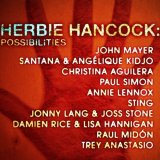Herbie Hancock, Possibilities
by john eischeid

After having won critical acclaim for The New Standard, Herbie Hancock has revisited contemporary popular music with his latest release, Possibilities. While The New Standard was a series of complex jazz takes on pop songs, such as "All Apologies" by Nirvana, Hancock has decided to work inside of the pop idiom, rather than of the song. His choice of collaborators evinces as much: John Mayer, Christina Aguilera, Paul Simon, Santana, and others no less notable. (See below for a complete list.) Hancock has never been one to blindly follow a predictable musical course, and this album appears to be an eclectic jazz/pop fusion, if one can imagine such an offspring. The union is far from unholy. Hancock uses jazz as the glue to bind an otherwise bizarre pastis. True to form, Hancock has ventured into new territory for himself; however, now it is in making music that is more accessible than esoteric.
A seamless marriage is “I Do It for Your Love,” featuring Paul Simon, whose melody complements Hancock’s musical stylings. The song originally appeared on Simon’s “Still Crazy After All These Years,” but he and Hancock changed the key to a minor one and added a family of percussionists. Hancock doesn’t just add bells and whistles; he dots the “i” s and crosses the “t”s of Simon’s melody over percussion parts that share lineage with Simon’s “Graceland.” The overall effect is one of sweet melancholy, as the two wander on their own separate but complementary ways, until finally arriving at the same single final note, in which both voices ring clear.
There is potential in a duet between Hancock and former Phish frontman Trey Anastasio. Rather than a triumphant high five, the piece “Gelo Na Montanha” comes off as more of a shrug. The piece was entirely an improvisation, to which neither artist is a stranger – Anastasio with his now-defunct, but legendary, jam band and Hancock throughout his career. Most notable of Hancock’s improvisational works are those that he did with Miles Davis on “In a Silent Way.” “Montanha” is a compromise, capturing both Anastasio’s genreless mode of expression and the deep blue atmosphere of Hancock’s work on “In a Silent Way.”
While Hancock works with established masters like Simon, Santana, and Anastasio, he courts some newer talent as well. “A Song for You” with Christina Aguilera is a far cry from the dirtiness of her past. The track was originally written by Leon Russell and has since been performed by the Carpenters, Joe Cocker, Cher, and – lest we forget – Merv Griffin. Aguilera demonstrates a degree of refinement that appears happily divorced from her former attire of lingerie with chaps and her explicitly rated moniker “X-tina.” She shows off unparalleled range and control, showing that she might very well be the better half of an unlikely couple. She is the song’s new crush, at a time when both seem to be recovering from a string of sometimes dubious exes.
In a genre in which the artists are constantly reinventing themselves, Hancock appears to be assisting them in the process. The list of featured artists reads like a who’s-who of the most talented artists in contemporary popular music (excluding hip hop and rap). Hancock goes one step further with the genre, injecting his imagination and refinement gained from jazz. The labels themselves have collaborated on the album; it is a partnership among Hancock Music, Vector Records, and Starbucks' Hear Music, the label behind the same at-the-coffee-counter kiosks that catapulted sales of albums by artists such as Madeline Peyroux and Antigone Rising. Carlos Santana reportedly told Hancock that Possibilities is his Supernatural, the landmark album that won Santana two Grammys in 1999. The comparison is not a superficial one, as Hancock has plumbed depths of pop music at a time when such depths are thought to be long gone.
Copyright (c) 2005 erasing clouds |
|